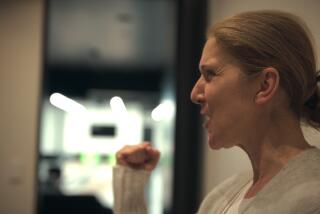Illness Only Strengthens Couple’s Love
- Share via
This is a story about love and an illness that had no name.
They were 19 when they met. John Garrett was a drama student and Cynthia Toussaint was a ballerina. Cynthia’s mother was hosting a cast party for a community theater production of “You Can’t Take It With You.”
“When he walked in the door, I said, ‘Who is he?’ ” That night Cynthia told a girlfriend: “I’m going to marry him.”
That was 15 years ago. John and Cynthia are still together, but they still aren’t married, all because of the illness that had no name.
The sweethearts headed from the Bay Area to UC Irvine to pursue their dreams of drama and dance. But one day in ballet class, Cynthia tore the hamstring muscle in her right leg. “They told me I couldn’t dance for eight weeks. That was horrible.” The weeks and months passed. “They kept telling me I’d get better. I just didn’t.” The hamstring healed, only to tear again.
But dancers, she was reminded, live with aches and pains. “Dance through the pain,” she was told. But this was excruciating--a burning, stabbing pain. “You’re going to be fine,” she was told. “Why make a big deal of it?”
Cynthia quit school. She was 22 when she landed a job working with an illusionist who made tigers disappear before audiences in Reno and Las Vegas. John stayed with her, his own dreams on hold. She loved performing, despite the pain, which only got worse and worse. One moment she’d be smiling on stage, the next she’d collapse in her dressing room, in agony. In Las Vegas, she tore the hamstring in her other leg.
She remembers looking in a mirror, thinking, “ ‘I’m never going to be on stage again.’ I knew in my head I was never going to get better. I knew the doctors were wrong.”
The doctors would be wrong for years. Diagnosis eluded them. “I got labeled real early,” she recalls. Her problem, several doctors suggested, was psychological, not physical. It was “psychosomatic” or “all in your head.”
One theorized that her pain was the manifestation of “a deep, dark secret--stage fright.” Another called it “tendinitis from Mars.” Once, about eight years ago, one physician thought it might be a rare condition called reflex sympathetic dystrophy syndrome, or RSD for short. It’s a disease of the nervous system that causes an intense pain response. The doctor, however, performed a test and ruled it out.
By then a judge had found that Cynthia had been disabled by her mysterious ailment, qualifying her for Supplemental Security Income and health coverage. But it was as though only the judge, John and her mother believed Cynthia’s problems were physical. Other family members and friends grew suspicious. Cynthia was, after all, prone to dramatics.
“I always felt I was being punished for being disabled,” she says.
John was often at her side when she saw her physicians, most of whom she met through her health plan with Kaiser Permanente. Over time the condition spread. Damage to her legs required her often to use a wheelchair. There was pain in her back, and her right arm contracted in a right angle at the elbow. Physical therapists were unable to straighten it.
John and Cynthia noticed a pattern. It was the male doctors who, unable to render a diagnosis, would suggest that maybe a psychiatrist would help. The two female doctors who saw her were no less baffled, but never doubted that something was physically wrong with Cynthia. One is her current physician, Dr. Shanti Suresh, an internist at Kaiser in Woodland Hills.
John gave up dreams of acting and found a job in banking. “There came a point I knew I wasn’t going to be leading a Gypsy lifestyle,” John says. “I just felt a deep responsibility to take care of the woman I love.”
There were periods when the pain was so acute that Cynthia could do little more than lie in bed. “It’s so sad because John will hug me and I’ll have to say it hurts, it hurts so much,” she says.
The couple has found happy times too. They packed up her wheelchair and took a vacation in Hawaii. Emboldened by that trip, they traveled to Paris last spring, fulfilling one of Cynthia’s childhood dreams. They rode the elevator at the Eiffel Tower only to discover a stairway leading to the observation decks. A French worker helped John hoist Cynthia to the top, a moment that inspired a crowd of onlookers to respond with applause and cheers. “It was wonderful,” she says.
It was in August that John Garrett first wrote to me, describing Cynthia’s determination to overcome her mysterious ailment. He thought it was an inspiring story--and he thought that perhaps somebody could recognize her illness.
In October, he wrote again. Dr. Suresh had made a diagnosis. Cynthia, she concluded, indeed suffers from RSD, a condition that was first recognized during the Civil War but is only now becoming better understood by physicians. It is highly variable from patient to patient, the only common denominator being pain.
Through Cynthia, Dr. Suresh declined a request for an interview. When told of Cynthia’s story, Dr. Philip J. Morgan, an Encino anesthesiologist who treats several RSD patients, said much of her experience is not unusual. It is very common, he said, for physicians unfamiliar with RSD to assume that the problem is psychosomatic.
“When doctors run into a wall, they tend to blame the patient,” Morgan said. “They say: Your bone’s healed, you’re crazy, and I don’t want to deal with you. Goodby.”
At the same time, Morgan added, RSD is rare and difficult to diagnose. And, he added, doctors sometimes do encounter patients whose problems are more psychological than physical.
There was bad news in the diagnosis. RSD may be cured only if the condition is identified early, Morgan says, usually within the first six months of its onset. RSD is not life-threatening, but prospects for improvement are not good.
But just being able to name her illness, just being able to answer people’s questions, have lifted a burden for the couple. “Now that I know what it is, I’m not as angry. I feel like I have a future.” Cynthia is hopeful that her diagnosis will help to mend relations with her siblings. And she wants to help educate people about RSD.
Suicide is an option chosen by some RSD sufferers. Cynthia says she can understand that. She figures she’s lucky. Many people, she says, aren’t so fortunate as to be with someone like John. They’ve stuck together through two years of health and 13 years of sickness, though they’ve never exchanged wedding vows.
Cynthia and John plan to do something like that in a little ceremony on New Year’s Eve, Cynthia’s 35th birthday. They will exchange rings and send out announcements. A legal marriage, they fear, could jeopardize Cynthia’s SSI benefits. They figure it will be a wedding just the same.
Scott Harris’ column appears Tuesdays, Thursdays and Sundays.
More to Read
Sign up for Essential California
The most important California stories and recommendations in your inbox every morning.
You may occasionally receive promotional content from the Los Angeles Times.













